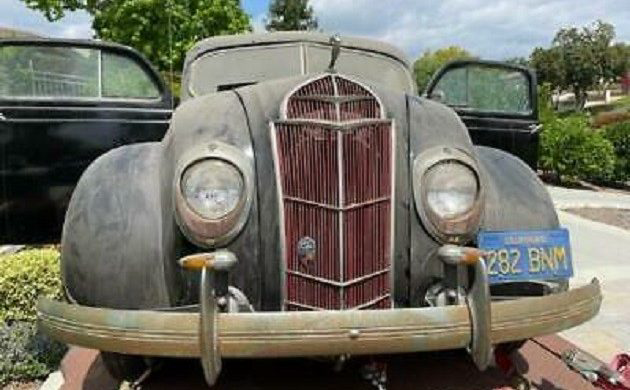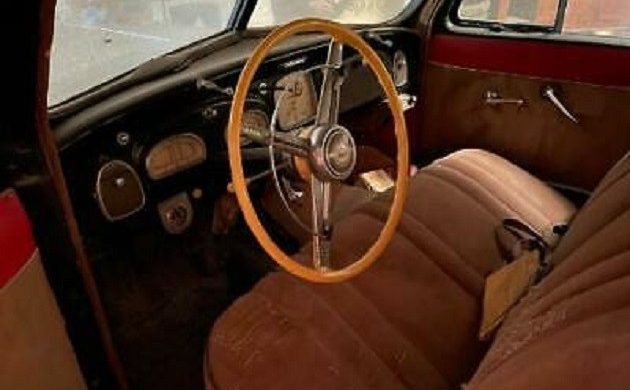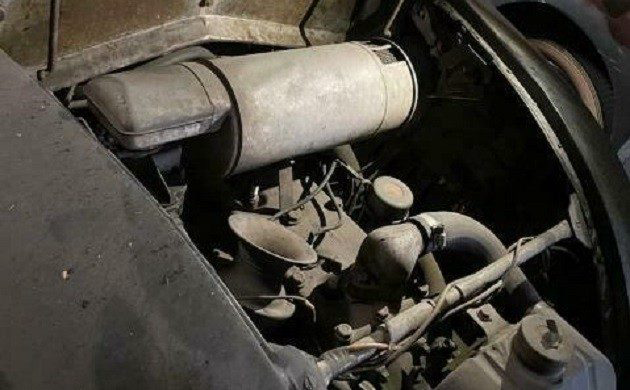The Airflow was one of the first production automobiles where aerodynamics played a role in the design of the car. Both Chrysler and DeSoto sold badge-engineered versions of the same cars from 1934-to 36 (and Chrysler one more year after that). Known today for their revolutionary styling and mechanical innovations, the cars were considered a marketing failure at the time. This 1935 DeSoto Airflow was found in storage where it had been for many years (last registered in 1986). This remarkable find is available in Covina, California, and here on eBay where the bidding stands at $9,850 with the reserve unmet.
There was a lot of fanfare when these cars were introduced. The Airflow’s design attempted to smooth away the wind-catching lines found on other autos of the era. The headlights were integrated into the design rather than just hung on and the grille was set up in a broad, waterfall style. The Airflow split the windshield into two panes of glass with each angled to better redirect the air around them and the rear wheels used skirts to redirect the flow of air, as well. Rumors surfaced that the design was unsafe, but those were unproven and may have been started by jealous competitors.
After building 55,000 copies of both the DeSoto and Chrysler Airflows, production stopped. The volume of sales was below expectations and the cars may have been considered too radical by a buying public that was just starting to bounce back after The Great Depression. The seller indicates his 1935 Airflow SG (a trim designation) was one of only 418 coupes built that year. It’s being sold out of an estate after having been in storage for at least 35 years.
The DeSoto has a 241 cubic inch flathead-six engine with 3-speed manual transmission using an overdrive. No attempt has been made to start it as the keys are missing and the title is MIA, too, so it will be sold only with a bill of sale. The machine was painted grey when built but wears black now which the seller believes will clean and shine up nicely, although the bumpers are pitted. The interior looks nice from what we can see, so this might not be a laborious project to at least get back on the road.






These cars always looked, from the front, like they should be somebody’s kindly Uncle Melvin.
Very cool car once restored.
This looks a lot like a VW Beetle to me – but still a nice design
According to legend, Ferdinand Porsche was a fan of the Airflow and had one delivered to Germany, where it inspired the shape of the VW Beetle. Historians are divided as to whether this story is true, but the resemblance is unmistakable.
The beetle shape was going around auto design circles in both Detroit and Central Europe in the early ’30s.
CCFisher,
A much larger influence on Herr Porsche was from Mr. Hans Ledwinka, the chief engineer for Tatra. Porsche used many of Ledwinka’s ideas, from Streamlining to basically copying the Tatra rear mounted flat 4 air cooled engine, as found in the pre-WW2 Tatra T-7.
A great book to learn more; Tatra: The Legacy of Hans Ledwinka. By Ivan Margolius [finally available on Amazon]
It’s a nice car, but these prewar cars are worth less and less. Even pristine cars that are prewar are losing value, simply by the impact of inflation and the people who remember these cars are dying off.
Yep, eventually people will only see prewar cars in museums. There will no longer be any “old guy” down the block with a prewar Packard, Cadillac, or Airflow parked in his garage.
Sad, but so true. And the day may come when only exotics survive – Duesenbergs, V16 Cadillacs etc.
Unfortunately, this is true, as well as for vehicles of other generations as well. There are fewer wrenchers that are able to work on them, and/or have an interest in the marque.
Beauty is in the eye of the beholder, note how our standards of what a “good looking car” is, have changed over the years. Radically different from what most people have has not sold well, no matter how “good looking” it is. Ford’s Lincoln Zepher of the same time was “streamlined” but had its basic Fords which were much different, styling wise, than their GM counterparts, until the 1940’s came out, but there were hundreds of thousands of them on the road, from 1935 – 1939, with integrated headlights, etc. so the Lincoln was not radically different. I think the Lincoln is much more attractive than the Airflows, but, that may just be me, but the public, then, thought so, too. On the other hand the Divco delivery trucks had the same sort of grill and they look just fine to me. Milk, bread, fish, and vegetables came to our suburban street in the late ’40’s in Divco’s, one car family, Dad had it to go to work, Mom stuck at home.
And now we’ve gone full circle, Kroger delivers….
Your wrong about prewar cars and here are two reasons why ,one not everyone buys for the investment value in antique cars. Many buy for style or historical factors , buying because they like it. I went to Hershey this year and there are no shortage of young people looking for parts for prewar cars at these types of events around the country, often bringing their children. and the lower cost of purchase of these cars means more people who could not afford them in the past are picking them up . you will not find them in the junk yard my friens
I have always loved this design, but like most Studebakers and Nash’s was just too advanced of a design for the general public of it’s time. I would love to have this, but out of my price range.
99 times out of a 100 this would be a four door. Very rare to see the 2 door sedan version.
Hate to say this, but I like the car and it would make a great resto mod for someone. The design seems to ask for muscle under the hood.
I’d like to join you in hating that you said this …
Closing in on $16,000.00 now with reserve unmet. With 3 plus days left for bidding, I wouldn’t be surprised to see it bid up to 25-30 K. I’ve always liked these Airflows with their Art Deco details. Alas I am going to be a spectator as usual. No space not enough money.
The coupe is a rare style, probably at the top of the Airflow food chain.
The steering wheel is a later replacement. The radio looks like a ’50s add on. Kinda looks like it was a daily driver for 20 or so years. Nice to see strong bidding to keep it out of the resto modders.
Whoa…80’s tags. So was in use well past the 50’s.
I have seen nice ones for this price. Bidder beware. If money is not a problem, go for it, but these can sell for 25K in decent condition.
Man, that thing needs a 426 HEMI in it.
Auction ended. No bids are listed. Private sale or cold feet?
Presorvation of prewar cars of this caliber , not restoration is where the hobby is headed now !